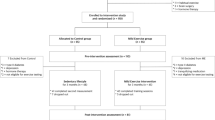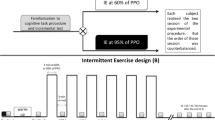Abstract
Purpose
Acute exercise improves selective aspects of cognition such as executive functioning. Animal studies suggest that some effects are based on exercise-induced alterations in serotonin (5-HT) secretion. This study evaluates the impact of different aerobic exercise intensities on 5-HT serum levels as well as on executive functioning considering 5-HT as a potential mediator.
Methods
121 young adults (23.8 ± 3.6 years) were examined in a randomized controlled trial including three exercise intervention (35 min) groups (low intensity, 45 % of the maximal heart rate (HRmax); moderate intensity, 65 % HRmax; high intensity, 85 % HRmax) and one control group. 5-HT levels and response inhibition (measured by a computerized Stroop test) were assessed pre- and post-intervention.
Results
There was a significant (p = 0.022) difference between groups regarding serum Δ5-HT levels. Post hoc tests indicated significant (p = 0.013) higher 5-HT serum levels for the high-intensity group compared to the control group while other groups did not differ significantly from each other. Serum Δ5-HT levels and exercise intensity were shown to be linearly associated through polynomial contrast analysis (p = 0.003). Furthermore, ANOVA revealed a significant difference for Stroop parameter reading (p = 0.030) and a tendency for reverse Stroop effect (p = 0.061). Correlation analysis showed that augmented 5-HT levels were associated with improved results in response inhibition.
Conclusions
This study indicates that intensive acute exercise increases serum 5-HT levels compared to a control group. These findings might be relevant for many other related research fields in exercise science, since 5-HT receptors are expressed on many different cell types including endothelia and immune cells.



Similar content being viewed by others
Abbreviations
- Δ5-HT levels:
-
5-Hydroxytryptamine levels at t 1 − t 0
- 5-HT:
-
5-Hydroxytryptamine
- a.m.:
-
Ante meridiem
- ANOVA:
-
Analysis of variance
- BBB:
-
Blood–brain barrier
- BDNF:
-
Brain-derived neurotrophic factor
- BMI:
-
Body mass index
- Bpm:
-
Beats per minute
- CG:
-
Control group
- CNS:
-
Central nervous system
- GXT:
-
Graded exercise test
- HI:
-
High intensity
- HLPC:
-
High-performance liquid chromatography
- HR:
-
Heart rate
- HRmax :
-
Maximal heart rate
- IGF-1:
-
Insulin-like growth factor 1
- LI:
-
Low intensity
- MI:
-
Moderate intensity
- Min:
-
Minutes
- MWT-B:
-
Multiple choice vocabulary test
- RCT:
-
Randomized controlled trial
- RPM:
-
Revolutions per minute
- Rpm:
-
Rotation per minute
- RT:
-
Reaction time
- SERT:
-
Serotonin transporter
- SPSS:
-
IBM SPSS Statistics
- TRP:
-
Tryptophan depletion
- VEGF:
-
Vascular endothelial growth factor
- WTS:
-
Wiener test system
References
Agawa H, Yamada N, Enomoto Y, Suzuki H, Hosono A, Arakawa K, Ghadimi R, Miyata M, Maeda K, Shibata K, Tokudome M, Goto C, Tokudome Y, Hoshino H, Imaeda N, Marumoto M, Suzuki S, Kobayashi M, Tokudome S (2008) Changes of mental stress biomarkers in ultramarathon. Int J Sports Med 29(11):867–871. doi:10.1055/s-2008-1038490
Audhya T, Adams JB, Johansen L (2012) Correlation of serotonin levels in CSF, platelets, plasma, and urine. Biochim Biophys Acta 1820(10):1496–1501. doi:10.1016/j.bbagen.2012.05.012
Ball G, Stokes PR, Rhodes RA, Bose SK, Rezek I, Wink A-M, Lord L-D, Mehta MA, Grasby PM, Turkheimer FE (2011) Executive functions and prefrontal cortex: a matter of persistence? Front Syst Neurosci 5:3. doi:10.3389/fnsys.2011.00003
Beckman D, Santos LE (2013) The importance of serotonin in exercise-induced adult neurogenesis: new evidence from Tph2−/− mice. J Neurosci 33(36):14283–14284. doi:10.1523/JNEUROSCI.2911-13.2013
Chang YK, Labban JD, Gapin JI, Etnier JL (2012) The effects of acute exercise on cognitive performance: a meta-analysis. Brain Res 1453:87–101. doi:10.1016/j.brainres.2012.02.068
Chaouloff F (1989) Physical exercise and brain monoamines: a review. Acta Physiol Scand 137(1):1–13. doi:10.1111/j.1748-1716.1989.tb08715.x
Chennaoui M, Grimaldi B, Fillion MP, Bonnin A, Drogou C, Fillion G, Guezennec CY (2000) Effects of physical training on functional activity of 5-HT1B receptors in rat central nervous system: role of 5-HT-moduline. Naunyn–Schmiedeberg’s Arch Pharmacol 361(6):600–604
Chennaoui M, Drogou C, Gomez-Merino D, Grimaldi B, Fillion G, Guezennec CY (2001) Endurance training effects on 5-HT(1B) receptors mRNA expression in cerebellum, striatum, frontal cortex and hippocampus of rats. Neurosci Lett 307(1):33–36
Chu C-H, Alderman BL, Wei G-X, Chang Y-K (2015a) Effects of acute aerobic exercise on motor response inhibition. An ERP study using the stop-signal task. J Sport Health Sci 4(1):73–81. doi:10.1016/j.jshs.2014.12.002
Chu C-H, Chen A-G, Hung T-M, Wang C-C, Chang Y-K (2015b) Exercise and fitness modulate cognitive function in older adults. Psychol Aging 30(4):842–848. doi:10.1037/pag0000047
Cohen J (1988) Statistical power analysis for the behavioral sciences. Erlbaum, Hillsdale
Cools R, Roberts AC, Robbins TW (2008) Serotoninergic regulation of emotional and behavioural control processes. Trends Cogn Sci 12(1):31–40. doi:10.1016/j.tics.2007.10.011
Dey S, Singh RH, Dey PK (1992) Exercise training: significance of regional alterations in serotonin metabolism of rat brain in relation to antidepressant effect of exercise. Physiol Behav 52(6):1095–1099
Diamond A (2013) Executive functions. Annu Rev Psychol 64:135–168. doi:10.1146/annurev-psych-113011-143750
Faul F, Erdfelder E, Lang A-G, Buchner A (2007) G*Power 3: a flexible statistical power analysis program for the social, behavioral, and biomedical sciences. Behav Res Methods 39(2):175–191
Ferris LT, Williams JS, Shen C-L (2007) The effect of acute exercise on serum brain-derived neurotrophic factor levels and cognitive function. Med Sci Sports Exerc 39(4):728–734. doi:10.1249/mss.0b013e31802f04c7
Fumoto M, Oshima T, Kamiya K, Kikuchi H, Seki Y, Nakatani Y, Yu X, Sekiyama T, Sato-Suzuki I, Arita H (2010) Ventral prefrontal cortex and serotonergic system activation during pedaling exercise induces negative mood improvement and increased alpha band in EEG. Behav Brain Res 213(1):1–9. doi:10.1016/j.bbr.2010.04.017
Hager W (2004) Testplanung zur Prüfung psychologischer Hypothesen. Die Ableitung von Vorhersagen und die Kontrolle der Determinanten des statistischen Tests, 1st edn. Hogrefe, Göttingen
Haider S, Khaliq S, Ahmed SP, Haleem DJ (2006) Long-term tryptophan administration enhances cognitive performance and increases 5HT metabolism in the hippocampus of female rats. Amino Acids 31(4):421–425. doi:10.1007/s00726-005-0310-x
Harmer CJ (2008) Serotonin and emotional processing: does it help explain antidepressant drug action? Neuropharmacology 55(6):1023–1028. doi:10.1016/j.neuropharm.2008.06.036
Hashimoto R, Nagatsu T, Ohta T, Mizutani M, Omura I (2004) Changes in the concentrations of tetrahydrobiopterin, the cofactor of tyrosine hydroxylase, in blood under physical stress and in depression. Ann N Y Acad Sci 1018:378–386. doi:10.1196/annals.1296.047
Hodge S, Bunting BP, Carr E, Strain JJ, Stewart-Knox BJ (2012) Obesity, whole blood serotonin and sex differences in healthy volunteers. Obesity Facts 5(3):399–407
Holst K, Guseva D, Schindler S, Sixt M, Braun A, Chopra H, Papst O, Ponimaskin E (2015) The serotonin receptor 5-HT7R regulates the morphology and migratory properties of dendritic cell. J Cell Sci 128(15):2866–2880
Homberg JR, Pattij T, Janssen MCW, Ronken E, de Boer SF, Schoffelmeer ANM, Cuppen E (2007) Serotonin transporter deficiency in rats improves inhibitory control but not behavioural flexibility. Eur J Neurosci 26(7):2066–2073. doi:10.1111/j.1460-9568.2007.05839.x
Hopkins ME, Bucci DJ (2010) BDNF expression in perirhinal cortex is associated with exercise-induced improvement in object recognition memory. Neurobiol Learn Mem 94(2):278–284. doi:10.1016/j.nlm.2010.06.006
Hüther G (2000) Das serotonerge System. UNI-MED Science, UNI-MED, Bremen
Klempin F, Beis D, Mosienko V, Kempermann G, Bader M, Alenina N (2013) Serotonin is required for exercise-induced adult hippocampal neurogenesis. J Neurosci 33(19):8270–8275. doi:10.1523/JNEUROSCI.5855-12.2013
Lin T-W, Kuo Y-M (2013) Exercise benefits brain function: the monoamine connection. Brain Sci 3(1):39–53. doi:10.3390/brainsci3010039
Lincoln J (1995) Innervation of cerebral arteries by nerves containing 5-hydroxytryptamine and noradrenaline. Pharmacol Ther 68(3):473–501
Lu Q, Hofferbert BV, Koo G, Malinauskas RA (2013) In vitro shear stress-induced platelet activation: sensitivity of human and bovine blood. Artif Organs 37(10):894–903. doi:10.1111/aor.12099
Mizutani K, Sonoda S, Karasawa N, Yamada K, Shimpo K, Chihara T, Takeuchi T, Hasegawa Y, Kubo K-Y (2013) Effects of exercise after focal cerebral cortex infarction on basal ganglion. Neurol Sci 34(6):861–867. doi:10.1007/s10072-012-1137-3
Nakatani Y, Sato-Suzuki I, Tsujino N, Nakasato A, Seki Y, Fumoto M, Arita H (2008) Augmented brain 5-HT crosses the blood–brain barrier through the 5-HT transporter in rat. Eur J Neurosci 27(9):2466–2472. doi:10.1111/j.1460-9568.2008.06201.x
Neeper SA, Gómez-Pinilla F, Choi J, Cotman C (1995) Exercise and brain neurotrophins. Nature 373(6510):109. doi:10.1038/373109a0
Ohmatsu S, Nakano H, Tominaga T, Terakawa Y, Murata T, Morioka S (2014) Activation of the serotonergic system by pedaling exercise changes anterior cingulate cortex activity and improves negative emotion. Behav Brain Res 270:112–117. doi:10.1016/j.bbr.2014.04.017
Patrick RP, Ames BN (2015) Vitamin D and the omega-3 fatty acids control serotonin synthesis and action, part 2: relevance for ADHD, bipolar disorder, schizophrenia, and impulsive behavior. FASEB J 29(6):2207–2222. doi:10.1096/fj.14-268342
Popova NK, Ivanova LN, Amstislavskaya TG, Melidi NN, Naumenko KS, Maslova LN, Bulygina VV (2001) Brain serotonin metabolism during water deprivation and hydration in rats. Neurosci Behav Physiol 31(3):327–332
Rojas Vega S, Strüder HK, Vera Wahrmann B, Schmidt A, Bloch W, Hollmann W (2006) Acute BDNF and cortisol response to low intensity exercise and following ramp incremental exercise to exhaustion in humans. Brain Res 1121(1):59–65. doi:10.1016/j.brainres.2006.08.105
Soares J, Naffah-Mazzacoratti MG, Cavalheiro EA (1994) Increased serotonin levels in physically trained men. Br J Med Biol Res 27(7):1635–1638
Steinberg LL, Sposito MM, Lauro FA, Tufik S, Mello MT, Naffah-Mazzacoratti MG, Cavalheiro EA, Silva AC (1998) Serum level of serotonin during rest and during exercise in paraplegic patients. Spinal Cord 36(1):18–20
Verburgh L, Königs M, Scherder EJA, Oosterlaan J (2014) Physical exercise and executive functions in preadolescent children, adolescents and young adults: a meta-analysis. Br J Sports Med 48(12):973–979. doi:10.1136/bjsports-2012-091441
Wakayama K, Ohtsuki S, Takanaga H, K-i Hosoya, Terasaki T (2002) Localization of norepinephrine and serotonin transporter in mouse brain capillary endothelial cells. Neurosci Res 44(2):173–180
Watts SW, Morrison SF, Davis RP, Barman SM (2012) Serotonin and blood pressure regulation. Pharmacol Rev 64(2):359–388
Weicker H, Strüder HK (2001) Influence of exercise on serotonergic neuromodulation in the brain. Amino Acids 20(1):35–47
Wilson WM, Marsden CA (1996) In vivo measurement of extracellular serotonin in the ventral hippocampus during treadmill running. Behav Pharmacol 7(1):101–104
Winter B, Breitenstein C, Mooren FC, Voelker K, Fobker M, Lechtermann A, Krueger K, Fromme A, Korsukewitz C, Floel A, Knecht S (2007) High impact running improves learning. Neurobiol Learn Mem 87(4):597–609. doi:10.1016/j.nlm.2006.11.003
Young LW, Darios ES, Watts SW (2015) An immunohistochemical analysis of SERT in the blood–brain barrier of the male rat brain. Histochem Cell Biol 144(4):321–329. doi:10.1007/s00418-015-1343-1
Zhao J, Lai L, Cheung SS, Cui S, An N, Feng W, Lorenzo S (2015) Hot environments decrease exercise capacity and elevate multiple neurotransmitters. Life Sci 141:74–80. doi:10.1016/j.lfs.2015.09.001
Acknowledgments
This research did not receive any specific grant from funding agencies in the public, commercial, or not-for-profit sectors. The authors would like to thank SCHUHFRIED GmbH for free access to the Stroop task hard- and software. Furthermore, the authors would like to thank Prof. Hans-Georg Predel for the opportunity to use his facilities as well as Dr. Peter Wright for editorial support.
Author information
Authors and Affiliations
Corresponding author
Ethics declarations
Conflict of interest
All authors have no conflicts of interest to declare.
Additional information
Communicated by Guido Ferretti.
P. Zimmer and C. Stritt contributed equally to that work.
Rights and permissions
About this article
Cite this article
Zimmer, P., Stritt, C., Bloch, W. et al. The effects of different aerobic exercise intensities on serum serotonin concentrations and their association with Stroop task performance: a randomized controlled trial. Eur J Appl Physiol 116, 2025–2034 (2016). https://doi.org/10.1007/s00421-016-3456-1
Received:
Accepted:
Published:
Issue Date:
DOI: https://doi.org/10.1007/s00421-016-3456-1




